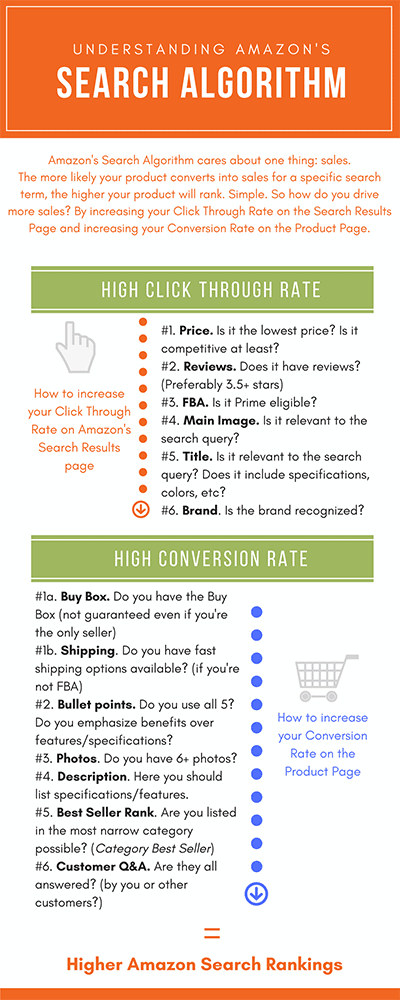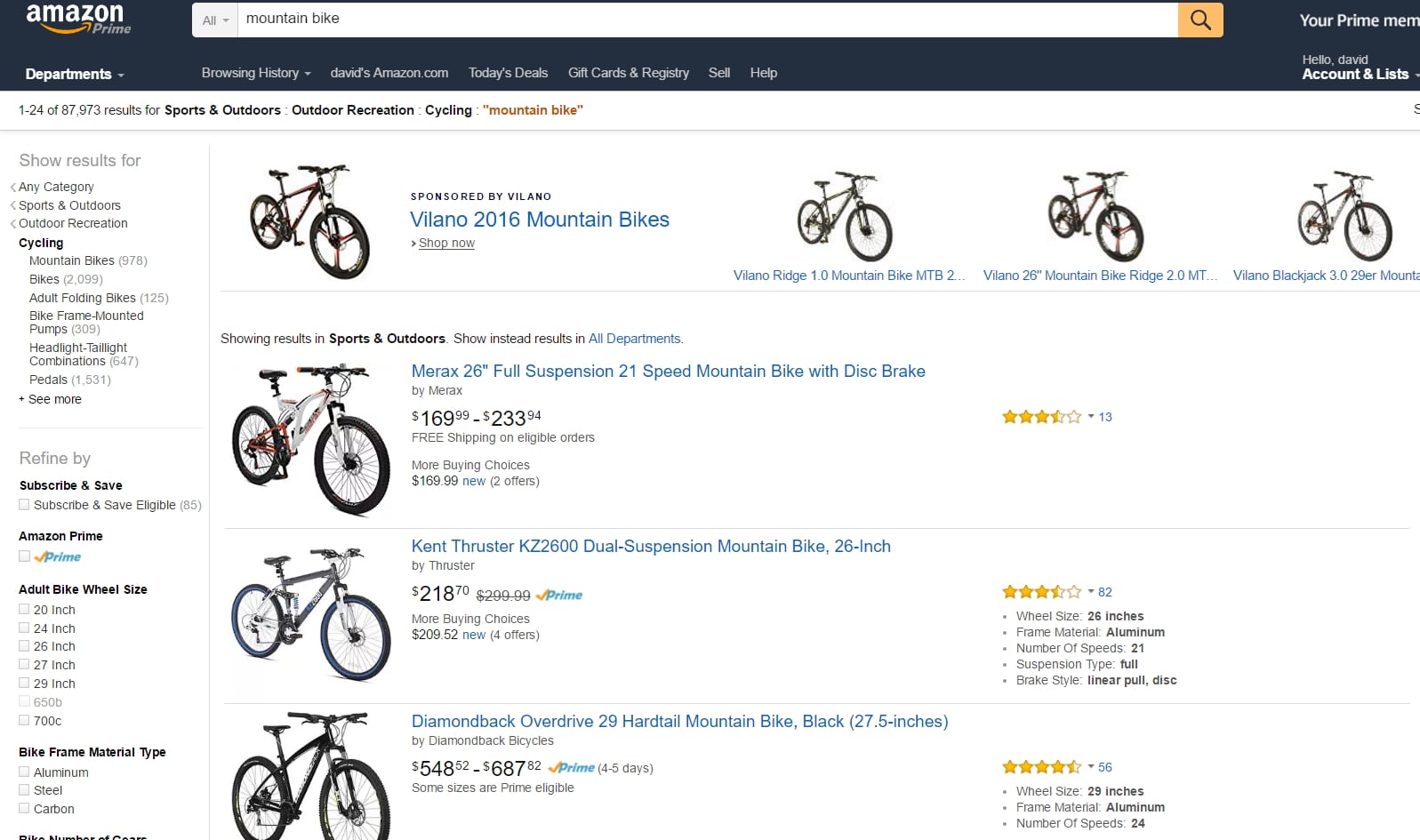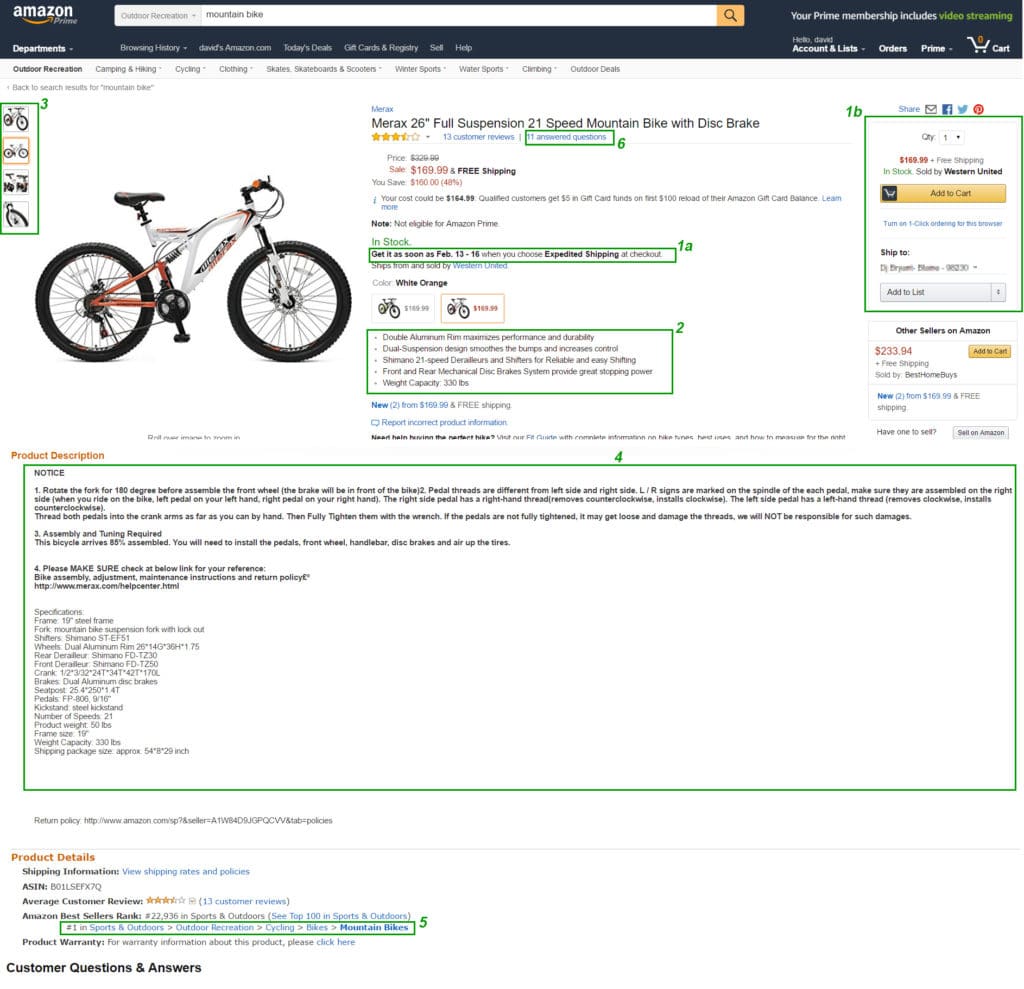Part 2: Understanding Amazon’s Search Algorithm

This is part 2 of a 3 part series:
Topics Covered
Part 1 Recap – Open an Amazon Account
In Part 1 of this guide, I discussed how to open your Amazon account and list your first product for sale with the bare minimum information possible. In the next parts, I am going to discuss how to optimize your listings to achieve the highest probability of ranking highly and converting into sales.
The first part of optimizing your listings is understanding how Amazon's search (formally referred to by Amazon as A9) algorithm works. Once you understand how it works, then optimizing your listing is pretty easy. So in this post, I'll explain how Amazon's search algorithm works.
Keep in mind, no one can say definitively how Amazon's search algorithm works except for the people at Amazon. Moreover, this post isn't backed up with hard facts and statistics – it's from my experience, others' experiences, and common sense. That last part especially is more than enough to put your understanding miles ahead of most other sellers on Amazon :)
Related Reading: Advanced Amazon A9 SEO Strategies
How the Amazon Search Algorithm Works

If you know anything about how traditional Search Engine Optimization works then you know Google and other search engines are basically trying to determine the relevancy and quality of your page in regards to the user's query. Amazon's Search Engine works in quite a different way. It rewards basically two things: your conversion rate and a customer's post-purchase satisfaction rate.
Conversion Rate
The first thing Amazon is going to look at is how likely is a user going to buy your product if they find it in the search results? Amazon's main raison d'etre is to maximize the number of sales they get. Amazon doesn't care if a product page has seven amazing product photos, a million 5-star reviews, or Nobel prize in literature worthy product descriptions. All they care about is whether you ultimately buy. The chances are good that those three things result in a higher likelihood to buy. However, if Amazon determines that the product with 1 crappy photo, 5 mediocre reviews, and a 1-sentence product description is going to result in more sales, they'll show that product.
Let's take an example of a search I did last summer. I was searching for a mountain bike. These are the top 3 search results I get when I search for Mountain Bike.

We can very approximately surmise that Amazon has concluded that someone searching for mountain bike is most likely going to buy one of those three bikes shown above. This is a HUGE simplification but for the sake of this exercise, it's a fair simplification to make.
So what makes one of those three bikes the most likely for someone to purchase? Well, the first step in increasing the likelihood that someone is going to buy one of the above bikes has to do with the click through ratio – or the likelihood that someone is going to click on the product from the search results. If you don't click through to the product detail page then you can't buy the product. Increasing our click-through ratios is one of the most important things we can do.
Increasing Your Click Through Rate on Search Results Pages

There are essentially six things that we can control on the search results page. I've ranked these in what I believe are the most important criteria. You may agree or disagree but from my experience, they seem to be fairly accurate.
- The price.
- The reviews.
- Whether the product is Prime eligible or not (i.e. whether it's fulfilled by Amazon)
- The main image.
- The title.
- The brand.
#1. Price: This is one of the most important things. You'll notice that most search results on Amazon have a mixture of low to high priced items, which essentially says that Amazon does not favor lower quality/lower priced items over higher quality/higher priced items. But your pricing needs to be good value (you can't sell $20 bills for $25). You'll also notice the top 10 search results for nearly any item almost always have a price leader in the results. Pricing yourself as the price leader is a very effective way to increase your search rankings (albeit not necessarily a profitable strategy)
#2. Reviews: The more reviews and the better reviews, the more likely someone is to click through to your product. You'll notice this particular bike has neither plenty of reviews nor plenty of good reviews. But the price is very low relative to the competition so likely consumers have determined they're prepared to sacrifice reviews (and subsequently quality) for a significantly discounted price. Reviews matter a lot more on the product detail page than the search results page, but they're still critically important.
#3. Prime Eligible: If your item is Prime eligible (i.e. it is fulfilled by Amazon) it will increase the conversion rate. Rather surprisingly this item isn't Prime eligible likely owing to the bulkiness of the product and the fact many bikes aren't prime eligible (for many product categories, not being prime eligible puts you at a HUGE disadvantage but often bulky and oversize items can still rank okay without being FBA).
#4. Product Image: The main product image in many ways is insignificant. Customers are looking at it at this point simply to determine if this is the product they are looking for. If you're looking for a mountain bike and the image shows a bike helmet, your likelihood of ranking high is very slim. There's not a lot you can do to optimize your main image aside from ensuring that it is completely legible.
#5. Product Title: If your item contains most or all of the customer's search query, it is going to have a higher likelihood of ranking well. For example, when we search simply for mountain bike, only 6 out of 25 non-paid search results have the phrase “21 speed” in it. But if we search for 21 speed mountain bike 13 out of 16 non-paid search results have the keyword “21 speed” in the title (don't ask why Amazon delivers different quantities of search results -that's another topic). This might sound obvious, but include search terms in your product title, especially specifications. (This is where you can really dominate ‘long tail' keywords, i.e. lightweight soccer cleats, toys for 1 year old, etc.) I'll go into more detail on the art of Keyword Stuffing in Part 3 of this guide.
#6. Product Brand: All other things equal, a strong brand (i.e. Norco) is going to sell more than a weak brand (i.e. Dave Bryant Bikes). It's likely that Amazon does apply some weight to well recognized brands. Having a strong brand is the holy grail of retail and isn't easily accomplished. However, you should be consistently branding your products from the beginning. In the long run, it'll help your sales.
An Aside: Getting Initial Search Traction with Keyword Stuffing
Maximizing your sales is the most important thing you can do to affect your search rankings BUT at some level Amazon is looking at contextual relevancy of your product without considering sales at all. For example, for a newly listed product, Amazon has no search history or sales history to base your products search rankings off of. They are simply going to rely upon the content you've provided for your product. This means there's some value in keyword stuffing, specifically in the title, bullet points, description, and keywords fields (in that order of importance). For example, if you've just launched a new dog collar, you could make the title “dog collar for large breeds such as golden retrievers” in the hopes of ranking for dog collar searches related to “large breeds” or “golden retrievers”. This likely won't be enough to get you to the first page of search results (except for truly long tailed keywords) without any sales history but it likely will be enough to rank you in later pages.
I'll go into more detail on keyword stuffing in the third part of this guide. It's important, especially initially, and it's also one of the easiest things you can do. But ultimately for long term success you need to focus on making sure your products are converting into sales well for customer search queries.
Increasing Your Conversion Rate on Product Detail Pages

So a customer has searched for your product and actually clicked through to the product detail page. Great! However, if every person that clicks through to your product detail page leaves without buying, then you will have a 0% conversion rate and Amazon is going to say to themselves “whenever someone searches for mountain bikes and clicks through to Dave's listing, they don't buy. Therefore, this isn't a relevant product for the mountain bike search query and we shouldn't show his listing”. The same thing would apply if 100% of people who clicked through ended up buying my product when they searched for mountain bike.
So what are the elements that you can control on the product description page to influence your conversion rate? Here's my top 6 (ignoring the other 6 items which we discussed for the search results page).
1a. Winning the Buy Box.
1b. Having fast shipping available.
2. Bullet points.
3. Product photos.
4. Product description.
5. Best Seller Rank.
6. Customer questions and answers.
#1a. Winning the Buy Box: You probably know the importance of winning the Buy Box so I won't go into great detail but know that you need to win it. And even if you are the only seller of an item, it is possible to not win the Buy Box if your seller feedback and/or operational metrics are low.
#1b. Having fast shipping available: If your product is fulfilled by Amazon then this is a non-issue. However, if your product is merchant fulfilled then you need to have fast shipping time which is shipping time + handling time. Moreover, you should have expedited shipping options available. Ecommerce customers, especially Amazon ecommerce customers, now expect products in under a week. If you can't do this, you'll lose a large percentage of potential customers and hurt your conversion rate.
#2. Bullet Points: This is perhaps the easiest thing to control with the most impact. Use every bullet point, focus on benefits over features while also including important specifications. The Merax bike page does a very goo job of this, i.e. Dual-suspension design smoothes the bumps and increases control. Bullet points have significant impact on your conversion rate.
#3. Product Photos: Use all of your available product photos (which is nine photos for most products). Your main image should be of excellent professional quality (use a product photo service preferably such as ProductPhoto.com). Your additional images should also be of excellent quality but if you don't have excellent photographs available, still upload as many good photographs as you can. Don't be afraid to be redundant – people appreciate as many photographs as they can get, even if the photographs are nearly identical albeit for a different angle or view.
#4. Product Description: There's a reason why the product description appears below the fold for many products – it's because nearly all customers will look at the product photos, most will read the bullet points, and only some will read the product description. If a customer makes it as far as the product description the chances are good that they are simply looking to see if the product has, or doesn't have, a specific feature. List every feature and dimension possible in your product description.
#5. Best Seller Rank: Many customers simply buy a product that is one of the best sellers in a specific category. Obviously having a best selling product is important but one of the easiest things you can control is having your product in the most appropriate category as possible and as furthest down the product catalog tree as possible, i.e as in the case of the Merax bike, being listed in the Mountain Bikes category and not just the Bikes category.
#6. Customer Questions and Answers: Customer questions and answers are essentially the most informative FAQ ever – they're real questions asked by real customers. These questions should always be responded to as soon as possible (assuming another customer has not already responded).
Your Seller Feedback & Operational Metrics

There's another factor which will affect your conversion rate and/or search rankings: your seller feedback.
Your seller feedback is the feedback people leave you as a seller (it's separate from product reviews). Your operational metrics are the criteria Amazon ranks you on such as valid tracking confirmation rate, response rates, cancellation rate, etc.
Both of these things can definitely affect conversion rate and search rankings for one reason: if your seller feedback or operational metrics fall below a certain level you will lose the Buy Box across all of your listings. I have a sneaking suspicion it's not an all or nothing game for Amazon though meaning that below average seller feedback/operational metrics will affect your search rankings even if you don't lose the Buy Box (albeit at a very minimal level).
Conclusion
This concludes Part 2 of this Amazon guide on detailing how the Amazon search engine works. There might be some controversy to some of the points I've made here but I strongly believe the fundamentals in what I've outlined here are solid. Essentially it comes down to ensuring your products convert into more sales for specific search queries than your competition. Easy right? If you can do this, then you're eventually going to find yourself ranking well in Amazon search. In Part 3 of this guide, I will take the fundamentals outlined here and outline clear action points for creating high converting pages.
What are your thoughts? Did I cover the most important parts of how Amazon's search engine works? Or did I miss out anything important? Share your thoughts below in the comments section.




I am a newbie. Can you guide me to part 3 and beyond. I have already learned a lot from the first two.
Hi,
Part 3 is here: http://www.chineseimporting.com/part-3-optimizing-your-listings-for-amazon/
Until now, the majority of blog posts have been actionable marketing information about Amazon.
How to start an amazon business, how to set up PPC campaign and even the full on-page guide to optimization.
However, people have never gone into extreme depth on the Amazon A9 Algorithm and how to optimise perfectly.
Having worked with algorithms for over a decade now, it is pretty clear to me that Amazon does not only look like the Google of yesteryear, but it really IS IT. We truly do not think the Amazon product ranking algorithm is going to change all that much in the coming months and years. This is mainly due to the core reason that it is not their primary goal.
And based on the updates that could be implemented into the Amazon A9 algorithm and what that would result in, more complexity in ranking, it would benefit our clients and our personal Amazon businesses drastically